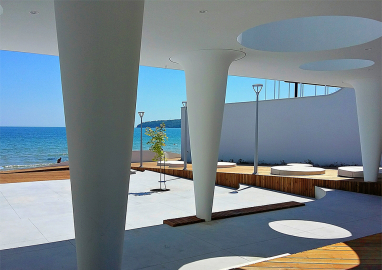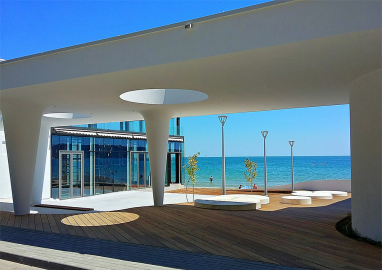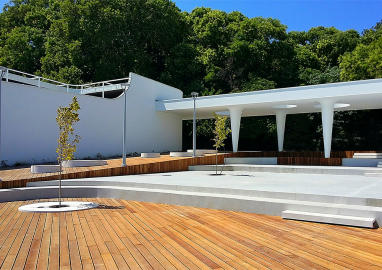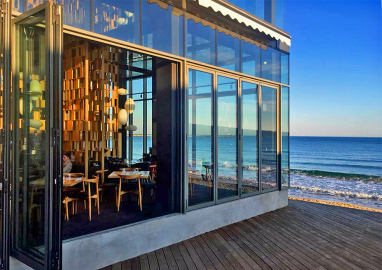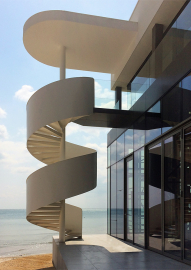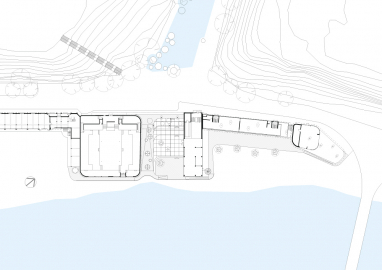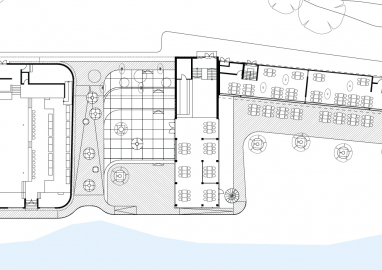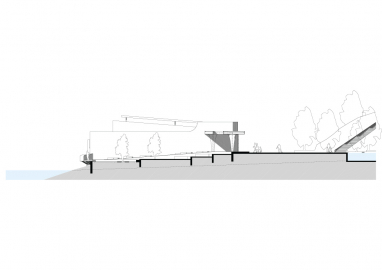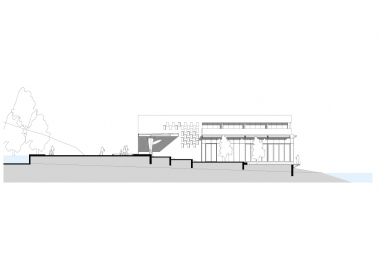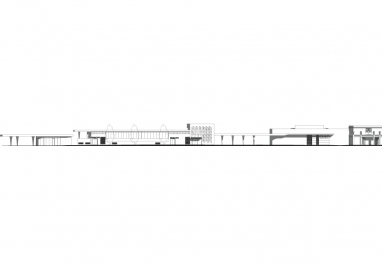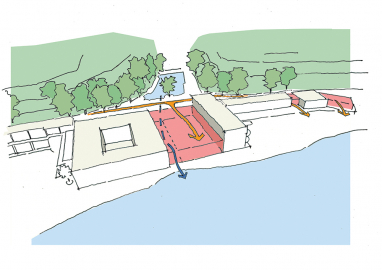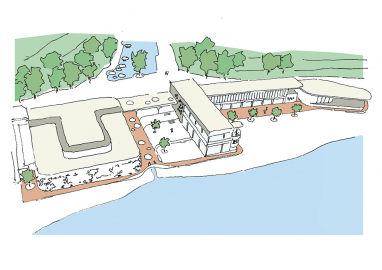Observation Point Varna Beach
The project encompasses an urban public square and adjacent pedestrian areas located immediately next to the Black Sea coastline in the city of Varna. It is part of a renovation project addressing existing buildings and public spaces in the contact zone between the city and the sealine, within close proximity to the Sea Garden, the city’s largest park.
The intervention site is situated at the communication backbone of Varna’s central coastal area referred to as Alley 1, the street bordering the beachline and the sea. A pedestrian extension next to the architectural site connects the square space with an artificial pond on the side of the Sea Garden, which is listed as tangible cultural heritage. Alley 1 is a popular recreation area with mostly seasonal and tourist-targeted operation. In the past decades, however, the potential of the year-round use has risen increasingly. Both public opinion and investors have shown interest in the zone looking toward a more sustainable model for its functionality.
The rehabilitation programme was aimed at this particular section of the alley to create a public and pedestrian space with reference to what was in the past an open area facing the beach. Proposed projects had to offer a solution for repairing the drainage canal associated with the pond.
Observation Point Varna Beach consists of two zones: a series of descending terraces with seating area and a ramp gradually declining towards the beach and then returning to Alley 1.
The seating area consist of three terraces descending towards the sea with 3-step denivelation between each level. The levels can be used as benches, as their edges are covered with wood. The final terrace is protracted above the shoreline providing an immediate view of the foaming waves.
The transition to Alley 1 is marked by a pergola bridging the adjacent buildings and visually framing the view of the sea. Stylistically reminiscent of 1960s’ modernism, it makes direct reference to the surrounding architecture initially designed and recently renovated in the spirit of this style, the most emblematic of which is the adjacent Lighthouse Restaurant that stands out with its external spiral staircase.
The ramp connects to the walking area thus framing the entirety of the space. Starting at the level of the Alley, the walking area descends towards the point of contact between square space and beach turning north at its lower end. It protrudes into an alley running parallel to the sea alongside the Lighthouse Restaurant and the frontline of adjacent buildings, eventually to rejoin the main Alley 1 by merging into its footway.
Under the ramp runs the canal of the Small pond, which is a drainage basin for the adjacent Sea-garden park. This pond has its own drainage system consisting of a series of filters managing overflow water, which eventually reaches the sea through the canal.
Prior to the transformation, the space was occupied by small-sized temporary constructions hosting entertainment businesses, which over the years acquired numerous additions and extensions, thus gradually forming a structure that blocked access from the alley to the sea and prevented the proper operation of the drainage canal.
The structures were erected outside any consideration of the spatial, stylistic or aesthetic context set by the Sea Garden. The project was developed and financed by commercial tenants in the area who had limited funds. Hence, our goal was to offer a design solution that would benefit both the local businesses and the public.
The design restores an urban pause – a combined recreation area and pedestrian alleys – which allows for a natural transition between key sites in the Sea Garden (Rock Garden and Wish Bridge) and the shoreline. It functions as a breakthrough not only visually but also by means of attracting and ensuring new pedestrian access to the beach and activities there.
An extra challenge was the short timeline allowed for design and construction. Both stages had to take place outside the active tourist season, for a total of nine months.
Seating space is static and characterised by white cement surfaces of concrete slabs and 3-step denivelation between each level. The white cement shapes several circular seating slabs in the ramp, which marks the walking direction along the alley.
The ramp signifies the movement covered in Siberian larch lamellae with distinctive diagonal raster. It has prefabricated removable steel structure and the wood cladding is mounted with gaps, so it can ‘bridge’ the canal and the beach beneath and let the rainwater flow easily.
The pergola and the columns use prefabricated steel structures with plasterboard and fiberglass cladding. These have been chosen due to their price and rapid implementation.
The final covering is white plaster, also used on reconstructed facades of the renovated buildings around the place. The railings are curved metal sheets painted in white referencing the sea waves.
The area’s landscaping includes climbers and creepers planted along the wall starting from the south and are meant to evoke the silhouette of the Sea Garden.

